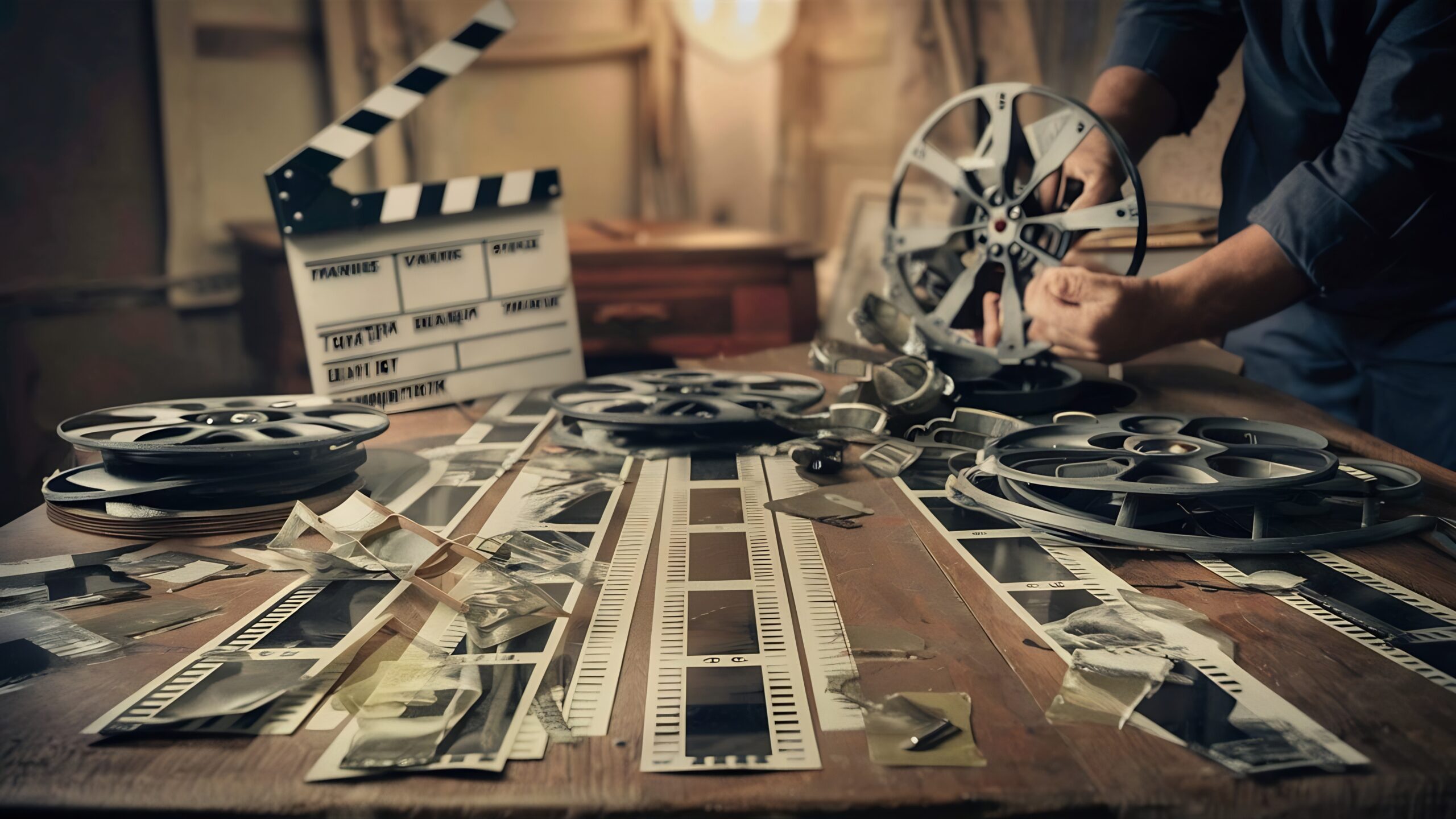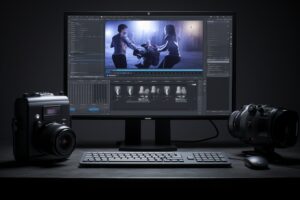10 Best Cinematic Video Editing Tips to Captivate Your Audience
As an aspiring filmmaker, you know that creating visually stunning and emotionally engaging videos is essential to captivate your audience and leave a lasting impression.
Cinematic video editing plays a crucial role in achieving this goal, as it allows you to transform raw footage into a polished and professional-looking final product.
In this article, we’ll dive into the 10 best cinematic video editing tips that will help you elevate your editing skills and create videos that stand out from the crowd.
Whether you’re just starting or looking to refine your techniques, these tips will provide you with the knowledge and inspiration you need to take your filmmaking to the next level.
So, let’s get started and explore the world of cinematic video editing together!
We strongly recommend that you check out our guide on how to take advantage of AI in today’s passive income economy.
Table of Contents
1. Master the Art of Pacing
One of the most important cinematic video editing tips is to master the art of pacing.
Pacing refers to the speed and rhythm at which your video unfolds, and it plays a crucial role in keeping your audience engaged and emotionally invested in your story.
To achieve the perfect pacing, you need to find the right balance between fast-paced, high-energy scenes and slower, more contemplative moments.
Use techniques like cutting on action, varying shot lengths, and employing strategic pauses to create a dynamic and engaging viewing experience.
Remember, the goal is to maintain a consistent flow that keeps your audience on the edge of their seats from beginning to end.
2. Embrace the Power of Color Grading
Color grading is another essential aspect of cinematic video editing that can transform the look and feel of your footage.
By adjusting the colors, contrast, and tones of your video, you can create a specific mood, evoke emotions, and establish a unique visual style.
Experiment with different color grading techniques, such as applying LUTs (Look-Up Tables), adjusting color wheels, or using curves to fine-tune the appearance of your footage.
Pay attention to the color palette of your scenes and ensure that the colors complement each other and support the overall narrative.
Color grading is a powerful tool that can help you create a cohesive and visually striking final product.
3. Utilize Dynamic Camera Movements
Cinematic video editing isn’t just about what happens in post-production; it also involves the way you capture your footage.
Incorporating dynamic camera movements into your shots can add depth, energy, and visual interest to your videos.
Techniques like tracking shots, dolly shots, and crane shots can help you create a sense of movement and immersion, drawing your audience deeper into the story.
When editing, pay attention to the continuity of these camera movements and ensure that they flow seamlessly from one shot to another.
Use them strategically to highlight important moments, reveal new information, or create a sense of anticipation.
4. Pay Attention to Sound Design
Sound design is an often-overlooked aspect of cinematic video editing, but it plays a crucial role in creating an immersive and emotional experience for your audience.
From the ambient sounds of a location to the carefully selected music that accompanies your visuals, every audio element contributes to the overall impact of your video.
When editing, take the time to carefully craft your sound design.
Choose music that complements the tone and mood of your scenes, and use sound effects to enhance the realism and depth of your footage.
Pay attention to the balance between dialogue, music, and sound effects, ensuring that each element is audible and supports the overall narrative.
5. Experiment with Non-Linear Storytelling
Non-linear storytelling is a powerful cinematic video editing technique that allows you to break free from the constraints of a chronological narrative.
By using techniques like flashbacks, flash-forwards, and parallel storylines, you can create a more engaging and emotionally resonant viewing experience.
When editing, consider how you can use non-linear storytelling to reveal new information, build suspense, or explore the inner lives of your characters.
Use transitions, such as cross-dissolves or match cuts, to seamlessly move between different time periods or storylines.
Non-linear storytelling can add depth and complexity to your videos, keeping your audience engaged and eager to unravel the mysteries of your story.
6. Leverage the Power of Montage
Montage is a classic cinematic video editing technique that involves combining a series of short shots or scenes to convey a particular idea, emotion, or passage of time.
By carefully selecting and juxtaposing different images, you can create a powerful visual narrative that communicates more than the sum of its parts.
When creating a montage, pay attention to the rhythm and pacing of your cuts.
Use techniques like cross-cutting, parallel editing, or thematic linking to create a sense of unity and coherence between the different elements.
Montages can be used to compress time, show character development, or highlight the emotional arc of your story.
7. Use Visual Effects Sparingly
Visual effects can be a powerful tool in cinematic video editing, but it’s important to use them sparingly and strategically.
While it’s tempting to add flashy transitions, elaborate motion graphics, or complex visual effects to your videos, overusing these elements can distract from your story and undermine the emotional impact of your footage.
When incorporating visual effects, make sure they serve a specific purpose and enhance the overall narrative.
Use them to create a specific mood, emphasize a particular moment, or seamlessly blend different elements together.
Remember, the goal is to create a cohesive and immersive viewing experience, not to showcase your technical prowess.
8. Collaborate with Other Creatives
Cinematic video editing is a collaborative process, and working with other creatives can help you bring your vision to life in new and exciting ways.
Whether it’s collaborating with a talented cinematographer to capture stunning visuals, working with a skilled sound designer to create an immersive audio experience, or partnering with a gifted writer to craft a compelling script, collaboration can elevate your videos to new heights.
When collaborating, be open to feedback and new ideas.
Listen to the perspectives of your collaborators and be willing to incorporate their insights into your editing process.
By working together, you can create videos that are greater than the sum of their parts and that resonate with audiences on a deep and meaningful level.
9. Study the Work of Master Filmmakers
One of the best ways to improve your cinematic video editing skills is to study the work of master filmmakers.
From the groundbreaking techniques of Alfred Hitchcock to the innovative storytelling of Christopher Nolan, there’s a wealth of inspiration and knowledge to be gained from analyzing the work of the greats.
Take the time to watch classic films and contemporary masterpieces, paying close attention to the editing techniques and storytelling strategies employed by the filmmakers.
Analyze how they use pacing, color, sound, and visual effects to create a specific mood or convey a particular message.
By studying the work of master filmmakers, you can develop a deeper understanding of the art and craft of cinematic video editing and apply those lessons to your own projects.
10. Embrace the Journey of Continuous Learning
Finally, one of the most important cinematic video editing tips for aspiring filmmakers is to embrace the journey of continuous learning.
Here is the paragraph rewritten to include the focus keyword “Cinematic Video Editing Tips” in the first sentence, in the middle, and in the last sentence:
Cinematic Video Editing Tips are constantly evolving, with new techniques, technologies, and trends emerging all the time in the world of video editing.
To stay ahead of the curve and continue growing as a filmmaker, it’s essential to adopt a mindset of lifelong learning and stay updated with the latest Cinematic Video Editing Tips.
Attend workshops and conferences, read industry blogs and magazines, and participate in online forums and communities where you can connect with other filmmakers and learn from their experiences.
Experiment with new techniques and tools, and don’t be afraid to take risks and push the boundaries of your creativity.
By embracing the journey of continuous learning and staying updated with the latest Cinematic Video Editing Tips, you’ll not only improve your skills as a filmmaker but also find new sources of inspiration and motivation to keep creating and innovating.
Conclusion
Cinematic Video Editing Tips are a powerful tool that can help aspiring filmmakers transform their raw footage into visually stunning and emotionally engaging final products.
By mastering the art of pacing, embracing the power of color grading, utilizing dynamic camera movements, and paying attention to sound design, you can create videos that stand out from the crowd and leave a lasting impression on your audience.
Remember to experiment with non-linear storytelling, leverage the power of montage, use Cinematic Video Editing Tips sparingly, collaborate with other creatives, study the work of master filmmakers, and embrace the journey of continuous learning to make the most of Cinematic Video Editing Tips.
By applying these cinematic video editing tips to your own projects, you’ll be well on your way to becoming a skilled and successful filmmaker.
So, grab your camera, fire up your editing software, and start bringing your creative vision to life!
FAQ Section
What makes a good cinematic video?
A good cinematic video is characterized by several key elements, including:
- Compelling storytelling that engages the audience emotionally
- Visually stunning cinematography with carefully composed shots and dynamic camera movements
- Effective use of color grading to create a specific mood or atmosphere
- Immersive sound design that complements the visuals and enhances the overall experience
- Seamless editing that maintains a consistent pace and flow throughout the video
By combining these elements, a cinematic video can transport the audience into the world of the story and leave a lasting impression.
How do I edit a video like cinematic?
To edit a video like cinematic, follow these steps:
- Start by organizing your footage and selecting the best shots that support your story
- Use techniques like color grading to create a cohesive visual style and evoke specific emotions
- Experiment with different editing techniques, such as montage, non-linear storytelling, and dynamic transitions to keep your audience engaged
- Pay close attention to pacing, ensuring that your video maintains a consistent rhythm and flow
- Incorporate immersive sound design, including music, sound effects, and dialogue, to create a multi-sensory experience for your audience
Remember, the key to cinematic editing is to focus on the story and use the editing process to enhance the emotional impact of your video.
Can you turn regular video into cinematic?
Yes, it is possible to turn regular video footage into a cinematic-looking final product through the use of various editing techniques and tools.
Some ways to achieve a cinematic look include:
- Color grading your footage to create a specific visual style or mood
- Using cinematic aspect ratios, such as 2.35:1 or 21:9, to create a widescreen look
- Applying film grain, vignettes, or other visual effects to simulate the appearance of film
- Incorporating dynamic camera movements, such as tracking shots or dolly zooms, through the use of editing software or plugins
- Adding cinematic music and sound design to enhance the emotional impact of your video
Keep in mind that while these techniques can help you achieve a cinematic look, the most important factor is the quality of your storytelling and the strength of your visual composition.
How do you get cinematic look when filming?
To get a cinematic look when filming, consider the following tips:
- Use a high-quality camera with manual settings to control aspects like aperture, shutter speed, and ISO
- Invest in good lenses that allow you to achieve shallow depth of field and create visually interesting compositions
- Pay attention to lighting, using techniques like three-point lighting or natural light to create depth and dimension in your shots
- Use a tripod or stabilizer to create smooth, steady camera movements and avoid shaky footage
- Experiment with different camera angles and shot types, such as wide shots, close-ups, and over-the-shoulder shots, to create visual variety and interest
- Consider the use of practical effects, such as fog machines or colored gels, to create a specific atmosphere or mood
By combining these techniques with strong storytelling and careful planning, you can capture footage that has a cinematic look and feel, even before the editing process begins.

We strongly recommend that you check out our guide on how to take advantage of AI in today’s passive income economy.




